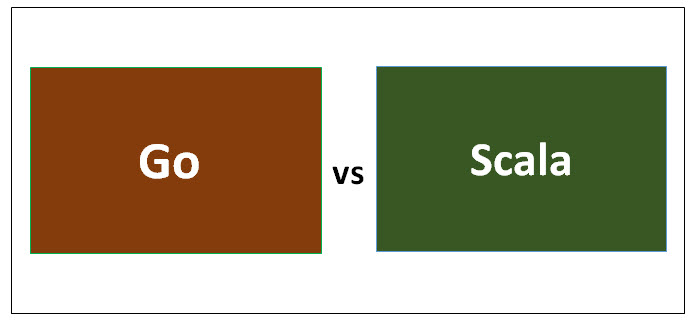Updated May 10, 2023

Difference Between Go vs Scala
Both Go vs Scala has their advantages and limitations. This depends upon the nature of the project and the client’s requirement specifications. GO – often called GOlang- does Google develop a Programming language (PL). It’s a statically typed, compiled language in the tradition of C. The tools, compiler, and source code are free and open source. SCALA – It’s a general-purpose programming language that supports functional programming and a robust static type system. (Source-Wiki).
Head-to-Head Comparison Between Go vs Scala (Infographics)
Below are the top 8 differences between Go vs Scala:
Key Differences Between Go vs Scala
Both are popular choices in the market; let us discuss some of the major differences:
While choosing programming languages, every company does some calculations, or you can say observation (from past experiences). Some of these are discussed below.
- Lesser code work is easier to understand
- The person who frequently uses or maintains a set of codes is not the one who created it (often).
Writing code is more of communication between the author and compiler and between the author and future readers (unknown skill level). These factors are crucial to determine at the project’s planning phase to avoid hindrances in delivery and smooth operations.
1. Simplicity – Go is more simple compared to Scala. The language specification page for Scala is more than 191 pages, whereas GO has only 51 pages. This simplicity is crucial for the team to decide to move swiftly into a project.
2. RISC and CISC – A CPU’s architecture can be of RISC and CISC model.
- RISC(Reduced Instruction Set Computing)
- CISC(Complex Instruction Set Computing)
RISC model uses only the more specific commands subdivided into many instructions to achieve low-level operation within a single CLK cycle, just like its name suggests, reduced instruction set computing.
3. CISC – Here, a single instruction can perform several low-level operations just the way it is pronounced. These low-level operations can be either memory load, Athematic operations, etc.
Back to Scala vs Go based on this model, GO provides a more straightforward and smaller set of orthogonal primitives that easily interact with ease and are expected. A developer can quickly build his need by learning a small number of primitives, whereas SCALA has a huge toolbox set and syntax. One has to know in detail and understand when to use these primitives for writing a few lines of code.
4. Practical – Let’s see a case comparing these two practices. Consider fetching a user id from a cookie.
Try to understand this case and analyze how much coding understanding is necessary before doing this.
- What if the cookie is not present?
- If the cookie value is not in standard format number?
- And also, what if the cookie-assigned value is a negative one?
Scala Code:
import play.api.mvc.RequestHeader
def getUserId()(implicit request: RequestHeader) = {
cookies.get("uid").map(_.value.toLong).filter(_ > 0)
}Go Code:
import (
"fmt"
"http"
"strconv"
)
func getUserId(r *http.Request) (int64, error) {
c, err := r.Cookie("uid")
if err != nil {
return 0, err
}
i, err := strconv.ParseInt(c.Value, 10, 64)
if err != nil {
return 0, err
}
if i <= 0 {
return 0, fmt.Errorf("invalid user id")
}
return i, nil
}Here one can see that the SCALA code is more minor than Go, but the thing is, Go is explicit, whereas Scala requires context to understand.
- Explicit codes are easier to understand for novices.
- Explicit code is easier to edit the changes.
- One can easily understand the error for explicit codes.
- These are even easier to debug.
5. Scalable concurrent solution – Regarding Scala vs Go, it is worth noticing what these PL can offer your company. SCALA is a persistent data structure, functional programming using first-class and closure, and Software transactional memory. In contrast, GO is a lightweight machine code language based on concepts of goroutines and UNIX pipe-like channels, high-speed compilation, and a simple abstraction mechanism.
Go vs Scala Comparison Table
Below is the topmost comparison between Go vs Scala:
| Basis of Comparison |
Go |
Scala |
| Initially release date | 10 November 2009 | 20 January 2004; |
| Stable release | 1.10.3 / 5 June 2018 | 2.12.6 / 27 April 2018 |
| Typing discipline | Strong, static, inferred, and structural | Static, strong, inferred, and structural |
| Filename extensions | .go | .scala and .sc |
| Designed and developed |
|
|
| Implementation language | Go, assembly language, C++ | Scala |
| Advantages |
|
|
| Features |
|
|
Conclusion
Scala is built on top of JVM. Scala supports built-in through a variety of built-in classes and 3rd party frameworks. GO provides concurrency in the form of goroutines and channels. A PL’s features and compatibility decide whether it will fit the available resources of the team or not—factors like code availability, understanding behavior, the complexity of writing code, and understanding by others.
Recommended Articles
This has been a guide to the top difference between Go vs Scala. Here we also discuss the Go vs Scala key differences with infographics and comparison table. You may also have a look at the following articles to learn more –

